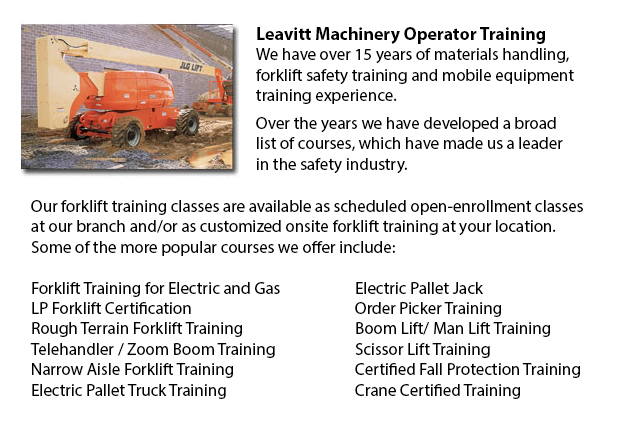
Mississauga Boom Lift Certification - Elevated work platforms allow maintenance operations and work to be done at levels which can not be reached by whichever other means. Boom Lift Certification Training educates workers about safely operating boom lifts and scissor lifts.
When work platforms are operated unsafely, they have the possibility for serious injury and even death, regardless of their lift style, application or the site conditions. Electrocution, falls, tip-overs and crushed body parts could be the unfortunate result of wrong operating procedures.
To be able to avoid aerial lift accidents, people need to be qualified to train workers in the operation of the certain type of aerial lift they will be making use of. Controls should be easily accessible beside or in the platform of boom lifts utilized for carrying workers. Aerial lifts must not be be altered without the express permission of other recognized entity or the manufacturer. If you are renting a lift, make certain that it is maintained properly. Prior to utilizing, controls and safety devices should be inspected to ensure they are working correctly.
It is essential to follow safe operating procedures in order to avoid workplace accidents. Driving an aerial lift while the lift is extended must not be carried out, nevertheless, a few models are designed to be driven when the lift is extended. Always set brakes. Set outriggers, if available. Avoid slopes, but when needed use wheel chocks on slopes which do not exceed the manufacturer's slope limits. Adhere to load and weight limits of the manufacturer. When standing on the boom lift's platform, make use of a safety belt with a two-foot lanyard tied to the basket or boom or a full-body harness. Fall protection is not needed for scissor lifts that have guardrails. Do not sit or climb on guardrails.
The boom lift certification course provides instruction in the following fields: training and certification; safety guidelines to be able to prevent a tip-over; inspecting the work area and travel path; surface conditions and slopes; stability factors; other tips for maintaining stability; leverage; weight capacity; testing control functions; pre-operational inspection; safe operating practices; mounting a vehicle; overhead obstacles and power lines; safe driving procedures; utilizing harness and lanyards; PPE and fall protection; and avoid falling from platforms.
The successful trainee would become familiar with the following: pre-operational inspection procedures; training and authorization procedures; how to avoid tip-overs; factors affecting the stability of scissor and boom lifts; how to utilize PPE, how to use the testing control functions and fall prevention strategies.
-
Mississauga Crane Training Courses
Mississauga Crane Training Courses - The heavy equipment crane is intended to move, lift and lower heavy stuff. Normally, the crane comes outfitted along with a hoist, sheaves, and chains or wire ropes. Cranes are utilized in the manufacturing, const... More -
Mississauga Telehandler Ticket
Mississauga Telehandler Ticket - The telescopic handler or telehandler is a normally utilized machine in agricultural and industrial applications. This machine is the same in look to a forklift and even works in a similar way, even though telehandler... More -
Mississauga Overhead Crane Ticket
Mississauga Overhead Crane Ticket - An overhead crane is normally used in industrial environments. Likewise referred to as a bridge crane, this equipment includes parallel runways spanned by a traveling bridge. The component that lifts materials is t... More -
Mississauga Forklift Safety Training
Mississauga Forklift Safety Training - Any person who wants to operate a lift truck has to take a forklift safety training program in order to become a certified forklift truck operator. There are various ways to acquire forklift training. Courses ar... More -
Mississauga Heavy Equipment Training
Mississauga Heavy Equipment Training - Normally, the different kinds of heavy equipment training are divided into 2 categories of equipment: those that have rubber tires and tracked vehicles. Tracked vehicles include items such as excavators, cranes,... More -
Mississauga Loader Ticket
Mississauga Loader Ticket - Loaders have been created to operate practically anywhere. They offer optimal traction and maneuverability because of a heavy-duty oscillating joint which offers 45-degree rotating angles toward the left and right, with 10... More -
Mississauga Forklift Training School
Mississauga Forklift Training School - Why A Forklift Operator Must Take A Forklift Training School - Federal and industry regulators have established the criteria for forklift safety training based on their existing standards and regulations. People... More -
Mississauga Telehandler Certification
Mississauga Telehandler Certification - A telehandler certification course could be taken by potential operators who have previous experience with driving typical forklifts and for individuals with no previous experiences on a lift truck. The real-wo... More

Forklift Certification Mississauga
TOLL FREE: 1-888-254-6157
Mississauga, Ontario
forkliftcertificationmississauga.com
Email Us
About Us


